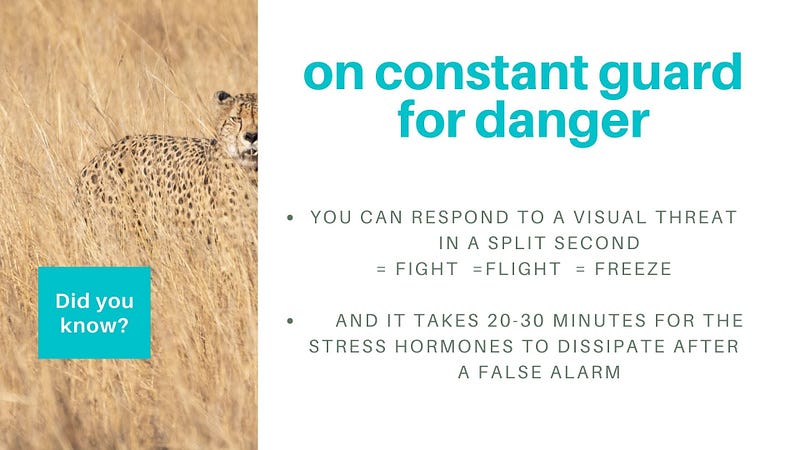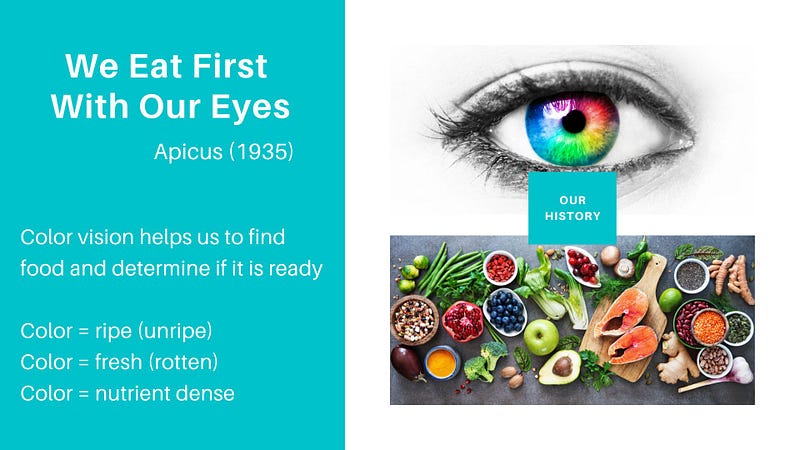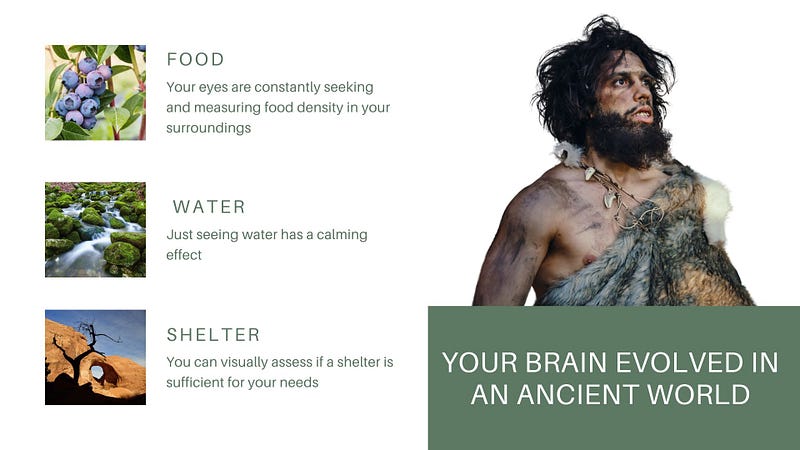Exploring the Eye of the Beholder: A Journey into Senses
Written on
Chapter 1: Introduction to Your Senses
This week marks the launch of the first installment in a five-part series titled "Your Senses in The Mind-Body-Food Connection" on Substack. Each section will delve into how our senses influence the Mind-Body Connection concerning food:
- Part I: The Eye of the Beholder (sight)
- Part II: Sentilicous Sensations (smell)
- Part III: Sound and Silence (hearing)
- Part IV: Our Tactile Tendencies (touch)
- Part V: Taste the Wonder (taste)
If you wish to explore these ideas in a more tailored and guided format, consider joining the waitlist for the upcoming Mind-Body-Food Connection Program at Food Abundance Revolution. For a complete experience of this series, a paid subscription is required.
We begin with sight, as it is predominantly the primary means by which humans gather information and understand their surroundings. The sight of a potential threat serves as the primary catalyst for our stress response, crucial for our survival. Moreover, sight also aids in locating food, water, and shelter, as well as interpreting social interactions. Thus, it is evident that vision plays a significant role in the Mind-Body-Food Connection. Let’s dive in!
Our Vision: A Marvel of Nature
Our eyes are remarkable creations of nature. As soon as light enters them, they begin to collect and process information. Remarkably, your eyes can transmit information to your brain at an astounding rate of 10 million bits per second (2006).
In everyday life, our eyes are involved in critical decisions, even if we don't always recognize their importance. When we witness something alarming, our brain sends signals that activate the sympathetic nervous system, which governs our stress reactions, commonly known as the "fight or flight" response. For instance, if your eyes detect a danger, such as a predator, they trigger an immediate and automatic bodily response.

Your eyes act as your initial defense mechanism (Source: Sue Senger with Canva Pro).
Interestingly, there are four potential stress responses rather than just two or three. While it's possible to train oneself to modify these responses, the instinct for survival remains hardwired within us. Even though most of us no longer encounter predators daily, our eyes continuously scan for signs of danger, which can keep us perpetually on edge.
However, here's a key point: your brain struggles to distinguish between actual threats and perceived ones. Consider the following scenarios:
- Witnessing a car accident can cause your heart to race as if you were directly involved.
- Seeing your displeased boss might trigger physical stress responses, even if she addresses someone else.
- Recounting a troubling event later can evoke the same stress reactions.
- Lying awake at night, replaying an unsettling incident, can also generate stress.
In each case, your body experiences stress even when the immediate danger is minimal. This explains why modern life often leaves us in a constant state of stress. We are inundated with visual stimuli at unprecedented rates in human history.
Interestingly, the brain processes visual information 60,000 times faster than textual information (2014). The images we encounter and the stress they elicit can replay in our minds, making us susceptible to stress-related health issues. Our focus and perception significantly influence our mental and physical state.
You may be able to see a star billions of miles away yet miss the concealed insect or predator right in front of you.
— Sue Senger
Connecting Sight and Food
Now, let's explore the link between vision and food. Our eyesight, stress reactions, focus, and attention have all evolved to ensure survival. As ancient humans living in a contemporary world, food remains essential for our survival, alongside water and shelter.
In our distant past, securing food consumed much of our daily existence. We needed to locate food, whether through hunting or gathering, or by cultivating it ourselves. Sufficient food equates to survival.
For millennia, we have relied on our vision to find food within our environment. Our color perception aids in determining when food is ripe for harvest or safe to consume.
We engage with food visually first.
— Apicus (1935)
With our eyes, we can easily tell if fruits and other foods are ripe or spoiled. Surprisingly, we also instinctively evaluate the nutrient density of our surroundings.

We visually assess available food options to make informed choices (Source: Sue Senger with Canva Pro).
Initially, I was skeptical about the idea of humans assessing nutrient density through sight. How could this be true? However, as I reflected on my experience as a biologist, it began to resonate.
For instance, in my role, I evaluate wildlife habitats and provide recommendations for development projects to safeguard or enhance those habitats. With years of experience, I can quickly ascertain whether an area is suitable for grizzly bears based on available food sources. I instinctively scan the landscape, counting food plants and signs of prey to determine if it can sustain a foraging bear.
While this task may appear straightforward in wildlife contexts, it poses challenges for humans. Unfortunately, few people today recognize what natural, nutrient-dense landscapes look like or understand the scale of food density needed to support human communities.
The closest experience may occur when you enter a grocery store, preparing to fill your cart. Regrettably, much of the food available is not health-promoting! You might also witness this skill when scanning restaurant menus in an unfamiliar area for appealing options.
Modern life has distanced us from the fundamental connection to our food, yet our eyes and brains still perform the same ancient calculations: Where is the food? In what condition is it? Is there enough? Do I need more? Our biological need for survival remains unchanged, even as our food systems become increasingly simplified.

You continue to search for food, water, and shelter, whether you consciously recognize this behavior or not (Source: Sue Senger with Canva Pro).
What Lies Ahead?
In the upcoming sections of "Eye of the Beholder — Part I," we will explore how your vision impacts your Mind-Body-Food Connection. Topics will include:
- The transition to contemporary eating habits and the resultant gaps in our visual-mind patterns related to food.
- How major food corporations manipulate visual cues to sell more products, empowering you to make informed decisions.
- How nature can recalibrate your perception of sight and balance your relationship with food.
- Practical activities that will enhance your understanding of your sight-food relationship on a personal level.
It remains uncertain whether this will unfold as one, two, or four posts. Regardless, join me at The Naturalized Human as a paid subscriber to not miss this captivating exploration!
Stay tuned!
Eye of the Beholder Part 2 is available exclusively on Substack:
The Eye of the Beholder - Part 2
As a reminder from Part 1, our vision plays a vital role in how we locate food, assess its quality, and ultimately nourish ourselves...
suesenger.substack.com
You might also like:
Harmony with Nature: Finding a Path Forward?
How can we achieve harmony with nature in our modern world? This question weighs heavily...
suesenger.substack.com
Understanding Ultra-Processed Food and Its Importance
Today, I aim to clarify some terminology to help you navigate the food landscape more effectively...
suesenger.substack.com
9 Expert Garden Hacks for Successful Transplanting
With the arrival of sunny days and warm nights, it's time to kick-start your vegetable garden...
suesenger.substack.com
The first video titled "Eye of the Beholder: Part 1" illustrates the significance of sight in our daily lives and its impact on our choices.
The second video, "Dragons Race to the Edge: Dragon Eye of the Beholder Part 1-3/9," explores themes of perception and observation in a fantastical context.